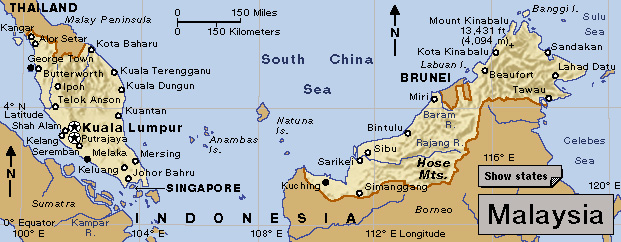Kuala Lumpur (pop. 1,674,621) is a federal territory of Malaysia. The territory includes Malaysia’s capital city, also called Kuala Lumpur, and an inland area surrounded by the state of Selangor. It occupies the central part of the Kelang Valley, at the junction of the Kelang and Gombek rivers, about 25 miles (40 kilometers) from the Strait of Malacca.

Nearly half the people of the Kuala Lumpur area are Chinese. About two-fifths are Malays. There are smaller numbers of Indians and other ethnic groups.
The Kuala Lumpur area is the seat of the federal government and the official residence of the yang di-pertuan agong (paramount ruler or king) of the country. The area is administered by the prime minister’s department. It has a mayor called the datuk bandar.
Kuala Lumpur is the national headquarters of administration, education, and cultural life, and the center of Malaysia’s industrial, commercial, and transport activities. One-fifth of the work force works for the government. Retail trade, factories, finance, insurance, and real estate sales also provide employment.
The area is an international center for trade in rubber, palm oil, and tin. Tin mining was an important industry from the mid-1800’s to the mid-1900’s, but most of the mines are now closed. Some of the abandoned mining areas have been turned into recreational water parks.
Rubber plantations occupy land in rural areas around the city of Kuala Lumpur. Fruits and vegetables are grown in some areas.
Kuala Lumpur is hot and humid throughout the year. The average temperature at Kuala Lumpur is 81 °F (27 °C). Differences in temperatures from month to month are small, but those between day and night are much higher. Temperatures may reach 90 °F (32 °C) at noon, but at night may drop to 75 °F (24 °C). Rainfall is high and varies between 90 and 140 inches (230 and 355 centimeters) a year. The wettest months are from April to November.
Kuala Lumpur began as a mining settlement by the Kelang River in the mid-1800’s. The area developed into a modern settlement with Malay inhabitants and Chinese people who established tin mines and other businesses.
When Selangor became a British protectorate, Kuala Lumpur was made the administrative headquarters of the British resident (government administrator) in 1879. In the following year, it became the capital of the state. The Federation of Malay States, consisting of Selangor, Perak, Negeri Sembilan, and Pahang, came into existence in 1896. Kuala Lumpur became the federal capital, a role it has played ever since.
When the rubber industry expanded in the 1890’s and 1900’s, Kuala Lumpur became the rubber-trading center. It handled the export of rubber and the dispatch of supplies to the new industry. When the road and railroad links connected the states on the west coast, Kuala Lumpur became the focus of communication. Its population grew from 30,000 in 1900 to 316,200 in 1957.
Kuala Lumpur became a city in 1972. Its status was changed to that of a federal territory area in 1974. In the process of this change, its area was enlarged from 36 square miles (94 square kilometers) to 95 square miles (245 square kilometers) by incorporating several nearby townships and villages.
